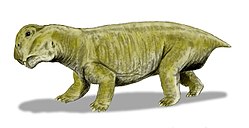| Lanthanostegus Temporal range: Late Permian [1] | |
|---|---|
| Scientific classification | |
| Domain: | Eukaryota |
| Kingdom: | Animalia |
| Phylum: | Chordata |
| Clade: | Synapsida |
| Clade: | Therapsida |
| Suborder: | † Anomodontia |
| Clade: | † Dicynodontia |
| Genus: | † Lanthanostegus Modesto et al., 2003 [2] |
| Type species | |
| †Lanthanostegus mohoii Modesto et al., 2002 [3] | |
Lanthanostegus is an extinct genus of non-mammalian synapsids from the Capitanian Tapinocephalus Assemblage Zone, Koonap Formation (Beaufort Group) of South Africa. The type and the only species is Lanthanostegus mohoii.





